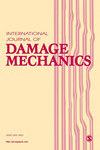基于多特征声发射和高斯混合模型聚类的混凝土损伤演变分析
IF 3.9
2区 工程技术
Q2 MATERIALS SCIENCE, MULTIDISCIPLINARY
引用次数: 0
摘要
本研究提出了一种基于多特征声发射(AE)和高斯混合模型(GMM)聚类的混凝土单轴压缩下损伤演化分析新方法。采用分层聚类算法选择最佳声发射参数,并通过主成分分析(PCA)生成这些参数的多个特征。然后利用多特征 GMM 聚类对混凝土损伤信号进行分离。同时,利用快速傅里叶变换(FFT)和连续小波变换(CWT)验证每个聚类中与混凝土损伤相关的波形信号。最后,根据 AE 特征的变化对混凝土在单轴压缩下的损伤演变过程进行了划分。结果表明,单轴受压下混凝土微裂缝、混合裂缝和摩擦的信号频率范围分别为 20-30kHz、20-65kHz 和 100-120kHz。根据累积能量曲线的拐点,将单轴压缩下混凝土的破坏过程分为三个阶段,即初始压实阶段、裂缝形成阶段和破坏阶段。本文章由计算机程序翻译,如有差异,请以英文原文为准。
Damage evolution analysis of concrete based on multi-feature acoustic emission and Gaussian mixture model clustering
In this work, a novel method for damage evolution analysis of concrete under uniaxial compression is proposed based on the multi-feature acoustic emission (AE) and the Gaussian mixture model (GMM) clustering. The hierarchical clustering algorithm is adopted to select optimal AE parameters, while multiple features of these parameters are generated through the principal component analysis (PCA). Then the concrete damage signals are separated by using the GMM clustering with multiple features. Meanwhile, the waveform signals associated with concrete damage in each cluster are validated using the Fast Fourier transform (FFT) and the continuous wavelet transform (CWT). Finally, the damage evolution process of concrete under uniaxial compression is divided based on the variation of AE characteristics. The results show that the frequency ranges of signals for micro-cracks, mixed cracks and friction of concrete under uniaxial compression are 20–30 kHz, 20–65 kHz, and 100–120 kHz, respectively. The damage process of concrete under uniaxial compression is divided into three stages according to the inflection points of the cumulative energy curve, namely the initial compaction stage, the crack formation stage and the failure stage.
求助全文
通过发布文献求助,成功后即可免费获取论文全文。
去求助
来源期刊

International Journal of Damage Mechanics
工程技术-材料科学:综合
CiteScore
8.70
自引率
26.20%
发文量
48
审稿时长
5.4 months
期刊介绍:
Featuring original, peer-reviewed papers by leading specialists from around the world, the International Journal of Damage Mechanics covers new developments in the science and engineering of fracture and damage mechanics.
Devoted to the prompt publication of original papers reporting the results of experimental or theoretical work on any aspect of research in the mechanics of fracture and damage assessment, the journal provides an effective mechanism to disseminate information not only within the research community but also between the reseach laboratory and industrial design department.
The journal also promotes and contributes to development of the concept of damage mechanics. This journal is a member of the Committee on Publication Ethics (COPE).
 求助内容:
求助内容: 应助结果提醒方式:
应助结果提醒方式:


